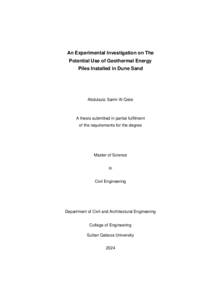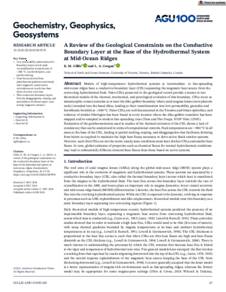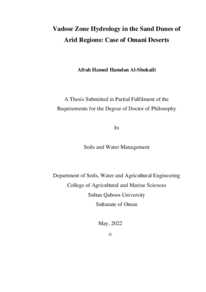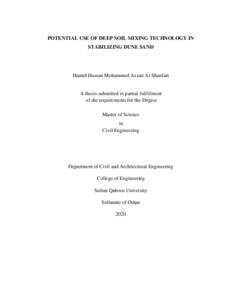Document
An Experimental investigation on the potential use of geothermal energy piles installed in dune sand.
Source
Master's thesis
Other titles
دراسة تجريبية حول الاستخدام المحتمل لركائز الطاقة الحرارية الأرضية المثبتة في تربة الكثبان الرملية
Country
Oman
City
Muscat
Publisher
Sultan Qaboos University
Gregorian
2024
Language
English
Thesis Type
Master's thesis
English abstract
Geothermal energy is a sustainable and renewable energy resource that can
be used to heat and cool buildings. Geothermal energy generation is based on
the facts that the earth temperature deeper than 15 meters is almost constant
throughout the year (10-15 °C). The geothermal energy piles are considered
as green foundations that could reduce the energy used to heat and cool
spaces by up to 75%. Geothermal energy pile (GEP) works as both a support
for the structures and a source of green energy to cool and heat the buildings.
This research focuses on studying the effects of different factors on heat
transfer performance of the geothermal energy pile installed in dune sand. The
factors considered in this research are the degree of saturation of soil, the
relative density of soil and the heating/cooling cycles.
A laboratory model setup was made to simulate the field test in a thermally
controlled environment. A geothermal energy pile was cast on a small-scale
(15x30cm) and was put in a tank (78x56x45cm) full of soil with thermocouples
embedded in both the pile and the soil to measure the temperature change
during the heating and cooling cycles.
During the heating and cooling cycles, the pile undergoes a thermal induced
strain due to the expansion or shrinkage of the pile, which leads to thermal
induced stress. During the heating cycle, the pile expands, and due to
confinement, the pile will develop a compressive stress, which increases the
overall stresses on the pile. However, in the cooling cycle the effect is the
opposite, as the pile tries to shrink while it is confined by the soil, it creates a
tensile stress in the pile, which when added to the compressive load of the
building, will reduce the total compressive load on the pile.
The selected soil was dune sand, as it has low bearing capacity and piles are
usually used with such type of soil. It was found that with the increase of the
soil saturation, the geothermal energy pile heat transfer performance has
increased in both heating and cooling. The improvement shown by the
saturated sand was in terms of the rate of the heat transfer between the pile
and the sand. It was also found that the increase in density showed a minimal
improvement in the heat transfer of the geothermal energy pile, however the
effect was more pronounced on the soil, as the dense sand exchanged the
heat faster to the surrounding atmosphere compared to the loose sand.
Arabic abstract
تعد الطاقة الحرارية الارضية مصدر طاقة مستدام ومتجدد يمكن استخدامه لتدفئة وتبريد المباني. يعتمد توليد الطاقة الحرارية الارضية على حقيقة أن درجة حرارة الارض على عمق 15 مترا فأكثر تعتبر ثابتة تقريبا على مدار العام )15-10 درجة مئوية(. تعتبر ركائز الطاقة الحرارية الارضية بمثابة أسس خضراء للمباني، يمكن أن تقلل من الطاقة المستخدمة لتدفئة وتبريد المساحات بنسبة تصل إلى .%75 تعمل ركائز الطاقة الحرارية الارضية )Piles Energy Geothermal )كأسس لدعم المباني بالاضافة الى كونها مصدر للطاقة الخضراء حيث تستعمل لغرض تبريد وتدفئة المباني. يركز هذا البحث على دراسة تأثير العوامل المختلفة على أداء الانتقال الحراري لركائز الطاقة الحرارية الارضية المثبتة في تربة الكثبان الرملية. العوامل التي تم أخذها في عين الاعتبار في هذا البحث هي درجة تشبع التربة والكثافة النسبية للتربة ودورات التدفئة / التبريد. تم إعداد نموذج مختبري لمحاكاة الاختبار الميداني في بيئة يتم التحكم فيها حراريا. تم صب ركائز الطاقة الحرارية الارضية على نطاق صغير )15 × 30 سم( وتم وضعها في خزان ) 78 × 56 × 45 سم( مليء بالتربة مع مزدوجات حرارية (Thermocouples (مدمجة في كل من ركائز الطاقة الحرارية الارضية والتربة لقياس تغير درجة الحرارة أثناء دورات التدفئة والتبريد. أثناء دورات التسخين والتبريد، تخضع ركائز الطاقة الحرارية الارضية النفعال مستحث حراريا بسبب تمدد أو انكماش الركائز، مما يؤدي إلى إجهاد حراري مستحث. أثناء دورة التسخين، تتمدد الركائز، وبسبب تقييد التربة للركائز، ستطور الركائز إجهاد انضغاطي، مما يزيد من الضغوط الكلية على الركائز. على النقيض من ذلك، في دورات التبريد يكون التأثير معاكسا، حيث تحاول الركائز الانكماش بينما تكون مقيدة بالتربة، مما يخلق اجهاد شد في الركائز، والذي عند إضافته إلى الاجهاد الانضغاطي الناتج عن حمل وزن المبنى، سيقلل من إجمالي الاجهاد الانضغاطي على الركائز. كانت التربة المختارة عبارة عن رمل الكثبان الرملية من والية بدية. تم اختيار هذا النوع من التربة بسبب تمتعها بقدرة تحمل منخفضة وعادة ما تستخدم الركائز مع هذا النوع من التربة. أوضحت النتائج أنه مع زيادة تشبع التربة، زاد كفاءة النقل الحراري لركائز الطاقة الحرارية الارضية في كل من دورتي التدفئة والتبريد. كان التحسن الذي أظهرته الرمال المشبعة على الرمال الجافة من حيث معدل سرعة انتقال الحرارة بين ركيزة الطاقة الحرارية الارضية والرمل. كما وجد أن الزيادة في الكثافة أظهرت تحسنا طفيفا في تبادل الحرارة مع ركيزة الطاقة الحرارية الارضية، ولكن التأثير كان أكثر وضوحا على التربة، حيث كان التبادل الحراري بين الرمال الكثيفة والجو المحيط أسرع مقارنة بالرمال السائبة )قليلة الكثافة(.
Category
Theses and Dissertations






